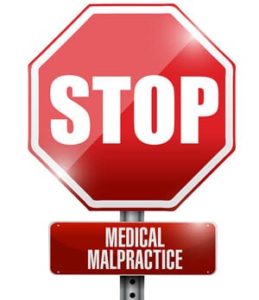 Free Consultation
(610) 667-7511
Free Consultation
(610) 667-7511
 Free Consultation
(610) 667-7511
Free Consultation
(610) 667-7511
Your right to be compensated for harm is fundamental to the American justice system. And yet, there are those who have tried (repeatedly) through so-called tort reform, to take away or minimize your rights to recover for pain, suffering, and loss of life’s enjoyments, by being dishonest about:
The reality is that health care costs increase every year, and lawsuits have nothing to do with the problem, medical malpractice insurance continues to increase in states with tort reform, and the number of lawsuits filed against doctors and hospitals each year in Pennsylvania and many other states has actually decreased.

Preventing reasonable recovery for malpractice does nothing to encourage hospitals and doctors to stop making so many mistakes.
In February 2017, the House of Representatives introduced an effort to stop you from obtaining reasonable and appropriate compensation for harm done to you by medical professionals and hospitals. The legislation, H.R. 1215 claims it seeks, “to improve patient access to health care services and provide improved medical care by reducing the excessive burden the liability places on the health care delivery system.” The problem is, that the health care system has fundamental problems. Those problems include cost, but they also include the substantial number of dangerous mistakes made by medical professionals. The number of deaths due to errors in hospitals alone have risen to the point where they are the 3rd leading cause of death in the United States.
How does insulating medical professionals against compensating the victims of the malpractice do anything to improve medical care? What incentive is there to decrease mistakes if no one is held to the right level of accountability for medical negligence? None, of course.
The legislation, called Protecting Access to Care Act of 2017, includes the following:
The statute of limitation is the time period by which someone is allowed to sue. In Pennsylvania, we have a two year statute of limitations. In some states the statutes are longer. However, many states also have something called the discovery rule. This rule allows people to lengthen the statute if they had no reasonable basis to be aware of the malpractice prior to the usual time period. In the legislation, the maximum statute of limitations, even under the discovery rule, is three years. This means that even if the victim had no reason to know that the doctor was the cause of their harm for years after their injury, they will be unable to receive any compensation once three years go by.
Children also see their rights limited under the legislation. Here in Pennsylvania, children can sue up to the age of 20, that is two years after they reach the age of majority. Under the legislation, children who are injured prior to their 8th birthday have to sue within three years of the injury, or by the time they are 8. This means that for minors who do not discover their injuries until they are adults, they lose the right to sue. The child’s choice is taken away.
This portion of the legislation is called, “Encouraging Speedy Resolution of Claims.” In reality, all it does is take away the rights of minors to sue when they are adults, and take away the rights of people who could not reasonably have discovered what caused their harm prior to three years, from receiving justice. There is nothing in the statute to require that insurance companies stop dragging their heels during litigation. There is nothing that will cause speedy resolution in this portion of the document.
The statute caps non-economic damages at $250,000. Economic damages are things such as wages, medical costs, direct expenses. Non-economic damages are emotional harm, pain and suffering, loss of life’s enjoyment and so on. While $250,000 may seem like a lot of money, imagine if you lost your arms and legs because a doctor failed to diagnose and treat sepsis properly, or a hospital caused sepsis through improper protocols. Would $250,000 seem like a lot when you have to spend the rest of your life in a wheelchair, reliant on other people to take care of you?
Jurors are not allowed to be told about the caps either. Judges are expected to reduce any non-economic amount awarded to the $250,000 amount. We have a juror system for a reason. Jurors are perfectly capable of looking at a situation and deciding how much compensation is appropriate. In addition, if the amount of compensation seems out of line, a Judge is allowed to reduce it to an appropriate amount. Our system is already set up to deal with any potential runaway jurors. Normally though, if a jury sets a high amount, it is because the damages are extreme and/or the medical provider was grossly negligent to a degree that greater compensation is appropriate.
The right to contract between two parties is a fundamental one. Lawyers tend to charge fees of around 40% for medical malpractice cases. This is because of the risk inherent in medical malpractice lawsuits and the substantial resources and time involved in bringing them. There are already limitations on what attorneys can charge for legal services under attorney ethics rules. Those rules state that attorneys are not allowed to charge excessive fees. In some states, the percentage allowed is specifically spelled out. H.R. would interfere with how the various states manage legal fees, by setting out a specific scheme for what attorneys can charge, based on percentage and amount of recovery.

H.R. 1215 is another way of shutting the courthouse doors against injury victims.
This portion of the legislation is called “Maximizing Patient Recovery.” We don’t believe this is its true intent. There is no doubt in our minds that the reason for the limitation is not to protect the clients, but to discourage attorneys from taking the cases. When fees are limited too much, bringing these expensive and time consuming suits become economically impossible. If attorneys cannot afford to bring medical malpractice cases because of percentage limitations, they will either refrain from taking medical malpractice cases at all, or will be required to charge their clients hourly fees instead of taking cases on contingency. Very few people can afford hourly rates to bring a lawsuit. In addition, clients will have to pay the costs in advance. Medical experts in malpractice cases can cost $5,000-$10,000 or more, just for a written opinion. As a result, the courthouse doors will be shut even further than they already are.
Many people are injured due to medical malpractice to the point where their lives are greatly impacted. Unfortunately, if the damage is not extensive enough, the limitations already in place because of the costs of bringing these case, make it impossible for lawyers to bring claims that aren’t worth a substantial sum. Adding more limitations will make it impossible for many more people to bring legitimate claims.
In many jurisdictions, if you are hurt by several doctors along with a hospital, the compensation can come from one or all of those who injured you. Everyone is equally responsible for paying out the judgment. This would change under the supposed “fair share” portion of the legislation. If the doctor is mainly responsible, this means the doctor may have to pay 90% and the hospital 10%. This may seem fair, but in many cases, hospitals have substantial insurance policies and doctors do not.
Imagine that you are hurt so badly that you can never work again, or you will have lifetime medical costs. Imagine that your baby is hurt due to a birth injury caused by a doctor and will have millions of dollars of medical care throughout their life. Now imagine that because of “fair share”, that you can only collect a small percentage of your verdict or settlement, leaving you responsible for the majority of those medical bills and lost wages. Exactly how is that fair when all parties are responsible for the harm you or your family member experienced, but you are left holding the bills?
The legislation allows those who are found liable for future damages, to pay out claims over a period of time, as long as the recovery amount is at least $50,000. It is very common for those injured due to medical malpractice to have substantial bills, medical and otherwise, because they are unable to work due to injuries. This legislation will allow insurance companies to spread their payments out over a long period if they desire to do so. If the victim is in need of more money faster, they will be forced to sell their compensation to a company, which will take a large portion of their total amount as payment. In addition, victims will not be able to control their own money. Money they could have invested wisely and seen grow over the years. This clause will not maximize patient recovery, it will decrease it substantially.

Resist the efforts by Congress to take away your rights. Speak up and let your federal legislators know that this law will not help lower costs and will only hurt innocent injury victims.
As with most cases of tort reform, the intent with isn’t really to help patients. The Protecting Access to Care Act of 2017 will not improve access to medical care. It will not lower insurance rates for people or for medical providers. All it will do is further limit the rights of seriously injured people to obtain fair compensation. People who are hurt because their doctors engaged in serious violations of the standard of care.
Recently, Florida’s Supreme Court accused that state’s legislature of creating a false crisis and found similar legislation unconstitutional. The Court specifically stated that, “[t]he caps on noneconomic damages … arbitrarily reduce damage awards for plaintiffs who suffer the most drastic injuries.” This federal legislation is no different. And remember, this legislation interferes with the rights of the states to determine how to handle cases within their own jurisdictions. H.R. 1215 shows an utter lack of respect for the rights of states to manage their own legal systems.
Don’t let Congress take away your rights. Don’t let anyone but a jury or a settlement agreement tell you what your medical malpractice case is worth. Don’t be fooled. Stand up and speak out against so-called tort reform. The only ones it helps are the insurance companies who are actually required to pay out the money when their insured seriously hurt you or your family member.
LOWENTHAL AND ABRAMS, P.C.

Contact us for a FREE consultation. No fee unless compensated.